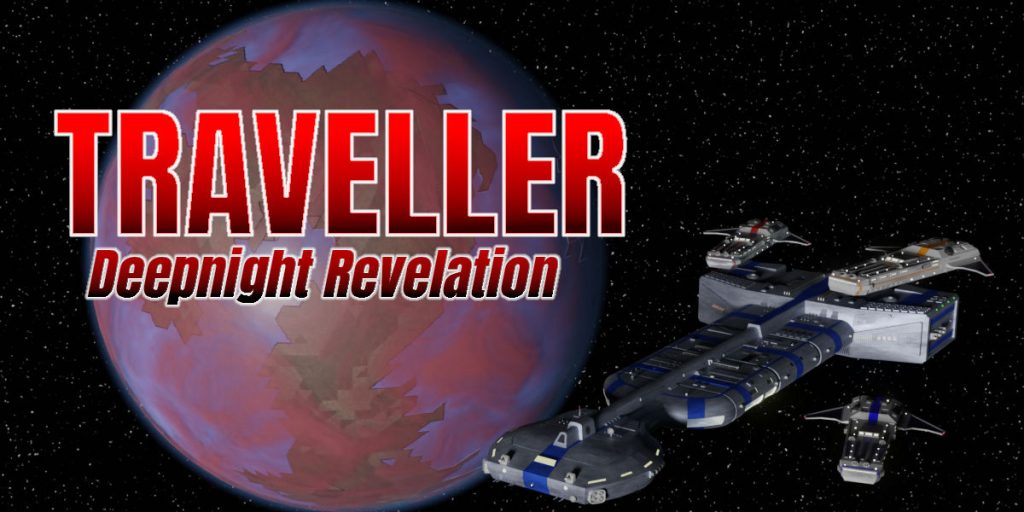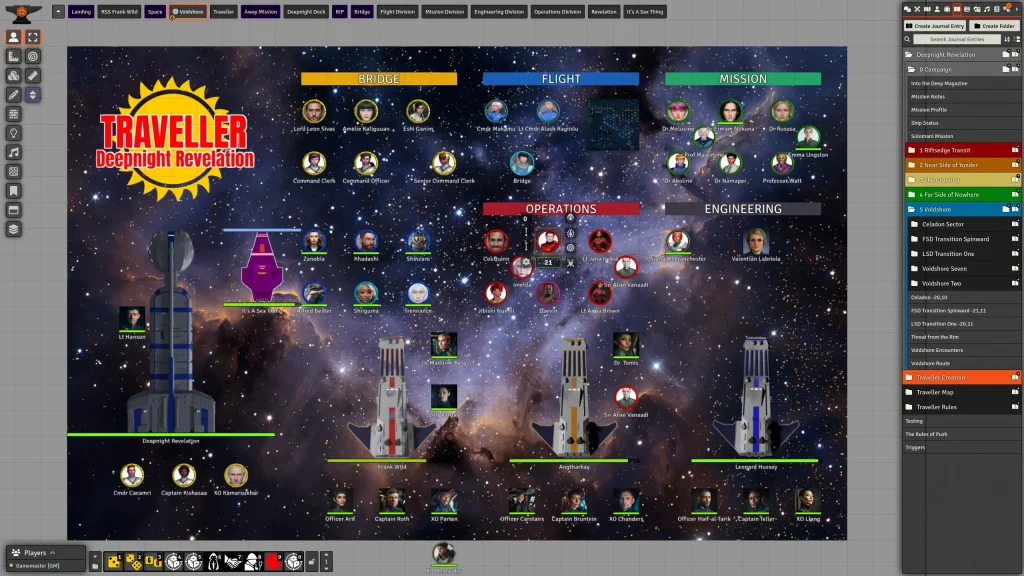Fieldman Anomaly

This is the session where the Deepnight Revelation meets up with the rest of the Solomani Fleet. Whilst waiting at Delta Psuden, they detect two exits from Jump space – the RSS Angtharkay and the RSS Leonard Hussey. When the Frank Wild contacts them, Commodore Bruntein of the Angtharkay is pleased to see that the Frank Wild has survived.
They are worried by the change in command, and then extremely puzzled when it’s mentioned that the current First Officer is someone they’ve never heard of. News of the events concerning the Deepnight Revelation is taken reasonably well, though it is decided, for the sake of simplicity, to ignore the events immediately following first contact between the Deepnight and the Frank Wild.
Whilst they wait for the ships to arrive at the planet, the crew on the surface continue to put together a game of Push. Unfortunately, it turns out (after a roll on the crew events table) that one of the anti-grav components that were borrowed from the Deepnight was a lot more important than anyone thought, and the drive is temporarily weakened. Due to various fixes, re-wiring, replacements and other changes, a critical part of the drive system is now being routed through a bit of the ship that didn’t use to be important. Now the crew are aware, and are able to document the changes.
The game also accidentally causes a wall to be knocked over. This is surprising, because it’s an uninhabited world with only very basic life, so why is there an ancient wall hidden in the bushes?
By the time the rest of the ships turn up, it is time for a meeting of the command staff of all the ships, and several presentations are given to explain each others mission. Both sides decide that teaming up is probably the most sensible course of action. They even fill the Imperium crew in on news that a war seems to have broken out on the border between Imperium and Zhodani space back in 1107, just after the Deepnight left. The Solomani don’t know how things turned out.
Now that they have a small fleet, I figured it was time to provide a new landing page for Foundry. I have all the main ships on there, as well as the main characters split into sectors for each division. The Traveller logo is clickable and opens up the latest issue of the Into the Deep Magazine, and there is an icon under Flight which opens up the current sector map.

The players seemed to like it.
As part of the information exchange, I wrote up the scientific reason for the Solomani Expedition as an interview between their head scientist and the Deepnight journalist who publishes the oboard magazine:
We have the opportunity to talk to Dr Anna Tomis, the lead scientist aboard the RSS Angtharkay. She has offered to give her time to explain the purpose of the Solomani Expedition, and some of the science and work behind it.
First of all, what is your connection to the expedition?
It was my father, Professor George Tomis, who performed the research that directly led to the mission. I worked with him in his final years to verify the research, and now I have the opportunity to carry his research to the next level.
For me, this is a very personal expidition, though it has great ramifications for the Solomani Confederation as well.
The Tomis Survey wasn’t the first to examine what we call Terminus Point though was it?
The Anomaly was first ‘discovered’ by Alan Fieldman in 1052, who was looking for something to do as part of his post-graduate work at Simonides University (Alderbaran/1314). The university had recently brought online the MGAD (em-gad, or Massive Gravity Array Detector), and it seemed like just the thing to investigate an unusual pulsar which had been first recorded during the Rule of Man.
What was thought to be an irregular pulsar, turned out to be something very different. It’s now simply known as the Fieldman Anomaly.
What was so odd about the Fieldman Anomaly?
The first oddity was that it wasn’t a point source. MGAD was able to resolve the object to a much finer resolution. What was discovered was that it was a region of high gravitational lensing, 2.4 AU in radius.
This implied that it was a black hole, but further work by Fieldman discovered that it was being orbited by a K8 star, which itself has multiple companions.
As well as the star, there are three large planetary masses in orbit around the central mas, as well as a shell of either gas or asteroid debris.
The orbital velocities of the other bodies in the system allowed an accurate estimate of the total mass of the system, and it was way, way lower than could be explained by a black hole of the required size.
The best computer models at the time suggested that there were multiple small high density objects. And by multiple, I mean in the hundreds or even thousands.
What did the Tomis Survey discover?
When my father began his survey of the system in 1087, he did it at the Otraidis Institute of Technology at Hyperia (Canopus/1931). This wasn’t a gravity based survey, but looked at radio and spectrographic data.
With the help of CELESTA, he was able to discover some pretty unusual features of the inner system.
CELESTA?
The Cosmic Exploration and Learning Engine for Scientific and Telescopic Analysis. It was an AI built by Thinking Machines Incorporated, and used by the Insitute for crunching the large amounts of data that was coming from their widely distributed telescopes.
What did he discover?
The inner core of the system seems to consist of a shell almost 5 AU across. The bulk of the mass is in that shell. It’s not a solid shell, so some have suggested that it could be a Dyson Swarm. However, it is dense enough to cause large amounts of gravitational lensing, so this seems unlikely.
However, this wasn’t what really interested him. There was a stellar sized mass inside the shell, at least 1.5 Sols in mass. The shell made it very hard to get any details of what is inside the shell, but with the help of CELESTA, it was able to tease enough information from the data.
According to the spectrographic data, there is a low mass Population II star inside the shell. This gives a maximum age to the star of 3.5 billion years. If our mass estimates are too low, which is possible, lifespan could be as low as one billion ways. Given it’s position in the galaxy, and the stars nearby, it is very unlikely for it to have formed recently. It shows every sign of being a star from the early formation of the galaxy, and it should be dead by now.
So why isn’t it?
That’s a good question. My own preferred theory is that the high gravitational region within the shell is causing time dilation, which has allowed the star to last until the present day. It is so unlikely that such a situation arose by chance, that it must have been designed.
What are the other theories?
They range from wormholes to a different spacetime, to a stellar construction project by the Ancients. I don’t think even the Ancients could build stars though, so my thoughts is that something much older built the Fieldman Anomaly. As to why, and how, I have no idea.
So what is the purpose of your Expedition?
It was funded mostly by the billionaire Investor Harry Marxis, who had some strange ideas but they coincided with my father’s research. Several universities and research institutions also helped in the funding and planning, thought some of them distanced themselves from Harry’s ideas.
We had nine ships initially, led by the light carrier Ustinov. The plan was to split, with the Angtharkay, Frank Wild and Leonard Hussey completing the trip to the Fieldman Anomaly. We left the rest of the fleet about 150 parsecs into the trip.
What was so odd about what Harry Marxis believed?
He believed in various conspiracy theories about the shape of the galaxy, and that everything had been created by an Ancients that came before the Ancients. His ideas aren’t backed up by science, but he became fixated on the Fieldman Anomaly and was willing to fund the expedition.
He was also leading the expedition, but suffered a heart attack 4 years into the mission. There is a deep space comet out there where he is buried.
In turn, the Deepnight team give presentations on the Entity, the Droyne, the Biologicals and the various other items of interest that they have come across.
After the information exchange, the two teams got together to explore the planet. This was a good opportunity for them to get to know each other, and figure out how to work together. The planet had gone through a major climate shift about 100K to 150K years ago. There was a civilisation, which had stone buildings, writing and metal tools and weapons. They were humanoid, tall with broad chests and long limbs.
About 99% of the animal life died out around the time that the civilisation collapsed. The climate got warmer and drier, and the air got thinner. There were no signs of other-worldly influence though. All the life here seems to have been native.
Several more children are born, and a part of the ship is baby-proofed. None of the parents are willing for either themselves or their children to be put into cold sleep. There are a couple of inquests, and some shuffling of the crew. The two fleets exchange liaison officers, but remove the Deepnight First Officer from the Frank Wild. The bomber that tried to blow up the Deepnight is found guilty of mutiny and executed. Captain Whelan is found guilty of failing his duty, but there are mitigating circumstances so he is demoted. Lt Carstairs, the Political Officer, is swapped with the Political Officer of the Angtharkay.
After the explorations are completed, the ships head onwards, reaching the sector of Voidshore Seven within a couple more weeks. Ahead of them are two systems showing signs of technological civilisation. Before approaching the first, the fleet starts to practice jumping in sync, so that they don’t risk coming out around a technological world with only one ship at a time.